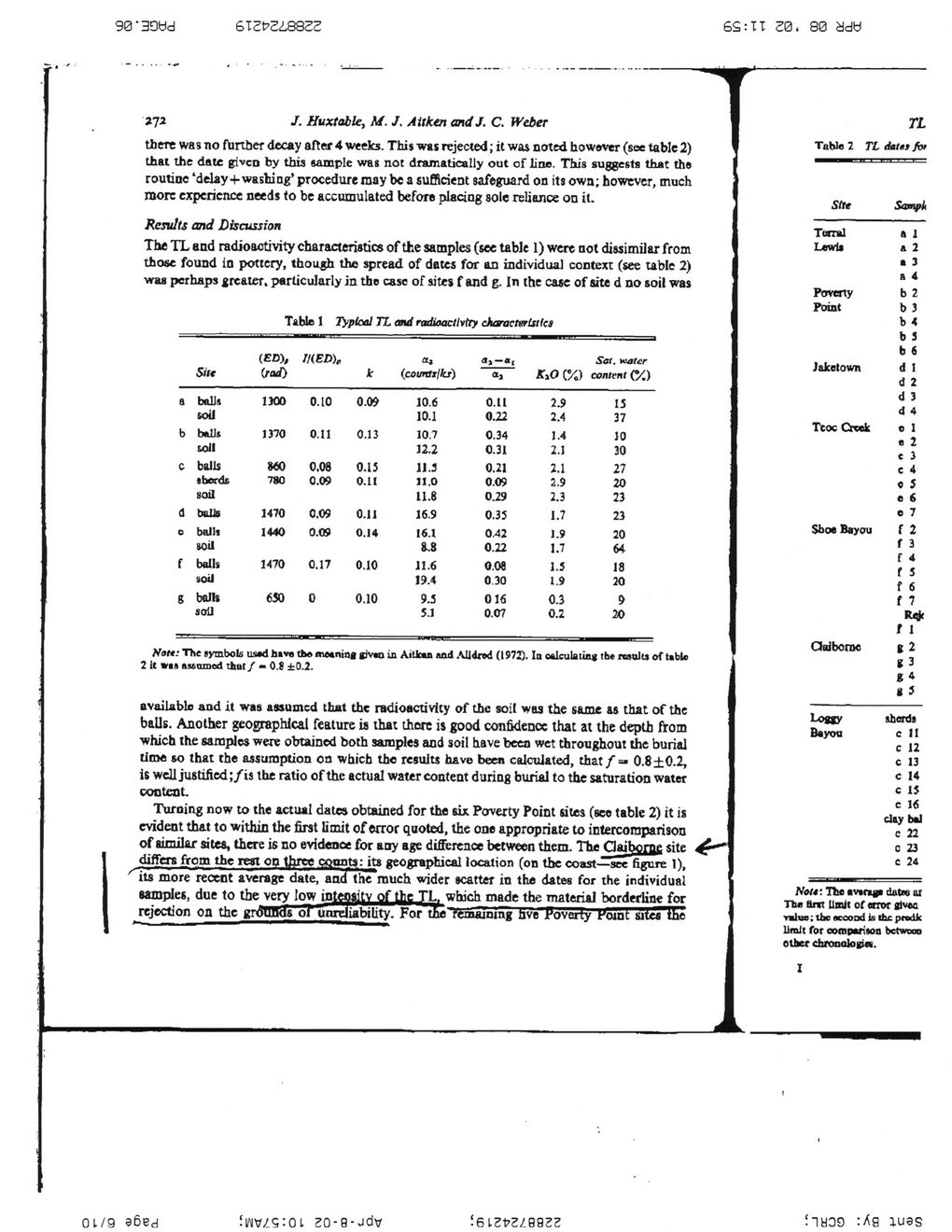This text was obtained via automated optical character recognition.
It has not been edited and may therefore contain several errors.
90' 39t)d 6T2t?2i882S 6S:TT 30. 80 add 272 /. Huxtable, M. J, A it ken andJ. C. Weber there was no further decay after 4 weeks. This was rejected; it was noted howsver (see table 2) that the date given by this sample was not dramatically out of line. This suggests that the routine ‘delay+wasting’ procedure may be a sufficient safeguard on its own; however, much more experience needs to be accumulated before placing sole reliance on it. Results and Discussion The TL and radioactivity characteristics of the samples (see table 1) were not dissimilar from those found in pottery, though the spread of dates for an individual context (see table 2) -vraa perhaps greater, particularly in the case of sites f and g. In the ease of site d no soil was Table 1 Typical TL and radioactivity characteristics Silt 11 IKED), k (courtiilkr) <h K>0 C%) Sat. water content (?/,) a balls 1)00 0.10 0.0* 10.6 o.u 2.9 15 soil 10.1 0.22 2.4 37 b b*Ut 1370 0.11 0.13 10.7 0.34 1.4 10 soil 12.2 0.31 2.1 30 c bolls 860 0.08 0.15 11.3 0.21 2.1 27 tberdc 780 0.09 0.11 11.0 0.09 20 soil 11.6 0.29 2.3 23 d balls 1470 0.09 0.11 16.9 0.35 1.7 23 0 balli 1440 0.09 0.14 16.1 0.42 1.9 20 soil 8.8 0.22 1.7 64 f balls 1470 0.17 0.10 11.6 0.08 1.5 18 soil 19.4 0 30 20 R balls 630 0 0.10 9.5 016 9 soil 5.1 0.07 20 Not*: The symbols us*d have th* meaning jpv*Q in Aitlaa and AUdfod (1972). Ia oalculatiag tht results of table 2 It was auoiDod that/ — 0.9 ±0.2. available and it was assumed that the radioactivity of the soil was the same as that of the balls. Another geographical feature is that thore is good confident* that at the depth from which the samples were obtained both samples and soil tiave been wet throughout the burial time so that the assumption on which the results have been calculated, chat f =* 0.8 ±0.2, is well justilied;/is the ratio of the actual water content during burial to the saturation water content. Turning now to the actual dates obtained for the six Poverty Point sites (see table 2) it is evident that to within the first limit of error quoted, the one appropriate to intercomparison of similar sites, there is no evidence for any age difference between them. The Claiborne site differs from the rest on three counts: its geographical location (on the coast—see figure 1), its more recent average date, and the much wider scatter in the dates for the individual samples, due to the very low intensity of the TL. which made the material borderline for rejection on the grounds ol unreliability. For tfce remajoing nve Poverty Koint sites the TL Table 2 TL data} for Site Sampk Tonal a 1 Lewis a 2 a 3 a 4 Poverty b 2 Point b 3 b 4 b 3 b 6 Jaketown d 1 d 2 d 3 d 4 Teoc Creek o 1 e 2 c i c 4 o 5 e 6 e 7 Shoe Bayou f 2 f 3 f 4 f 5 f 6 f 7 R<* t 1 Claiborne t 2 * 3 * 4 * 5 Loggy sherds Bayou e II c 12 c 13 c 14 c 1$ c 16 city twl c 22 o 23 e 24 Not*: The mnp datm ar The ant Until of error given value; the acooni is the prodic limit for oompariaon between oilier chronalogin. I 0 1/9 96ed fWVZSiOl 20-9-vidv J6l2t>2/_9922 iiyoo :Ag 1U9S

Claiborne Historical Site Archaeometry-Pp-269-275-(05)